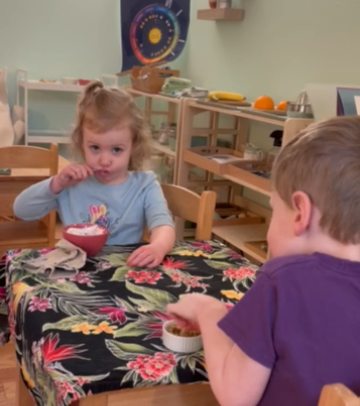
Snack time in a Montessori environment isn’t just about food—it’s about rhythm, choice, and independence. Whether I’m in the classroom or at home, I’ve found that when we treat snack time as a routine (not a free-for-all or a last-minute scramble), everything flows better. Children know what to expect, they feel empowered to meet their own needs, and I get a moment to breathe without constant interruptions.
If you’re tired of the grazing all day, meltdowns at the fridge, or constant “I’m huuungry,” this one’s for you.
Before I ever set up a snack routine, I just observed. In the classroom, I noticed when certain children consistently started to lose focus mid-morning. At home, I saw my own child wandering into the kitchen right before lunch—looking for something, anything, to nibble on. That’s how I knew we needed a structure.
Montessori always starts with observation. When is your child truly hungry? When are they bored? The answers to those questions can help you decide when and how to offer snack time.
In our school, we have a small snack station: a rolling cart with plates, cups, utensils, and a tray with the day’s snack. I also use a table with a tablecloth, set for two children and a dish-washing station in our kitchen. At home, I’ve recreated this in a low kitchen drawer and a child-sized table in the living room.
It doesn’t need to be fancy. A basket with fruit, a mini pitcher with water, and a cloth napkin goes a long way in supporting an independent snack routine. The key is making sure your child can reach everything and doesn’t need to ask for help every time.
At school, we gently model a rhythm: wash hands, choose a snack, pour a drink, sit at the table, and clean up afterward. I say it often and simply—”wash, eat, tidy”—and eventually I don’t need to say it at all.
At home, I used picture cards for a while to help my toddler remember the steps. It worked like magic during transitions. Snack time became something she could do without me hovering—and that made her feel so proud.
When I first introduced pouring water, I filled the pitcher with just enough for one glass. That way, even if it all spilled, we could handle it—and she still got to do it herself.
Later, we added scooping crackers, peeling bananas, and slicing strawberries. It’s tempting to set up everything at once when introducing a snack routine, but I’ve learned that starting small and layering in new tasks works best. The confidence builds over time.
If you’re interested in introducing targeted meal preparation skills, our practical life kits offer a complete solution (plus a parent guide)- these are the same ones we use in the classroom! You can find them here.
One of the hardest things for me (especially as a parent) was letting go of control. But when I started offering two snack options and letting my child choose when to eat from a set window (like between 9:30–10:30), everything shifted.
There were fewer meltdowns. She started listening to her body. And I stopped being the snack police.
This simple freedom—you choose what and when, within boundaries—aligns beautifully with Montessori’s respect for the child and their internal cues.
Montessori snack time always ends with cleanup. In the classroom, I show children how to use a sponge to wipe spills, push crumbs into a dustpan, and wash their own dishes. At home, my daughter now proudly brings her plate to the sink and wipes her place at the table.
Is it always perfect? Nope. Sometimes she misses a big drip of yogurt or drops the sponge on the floor. But the point isn’t to do it perfectly—it’s to practice responsibility and feel capable.
Snack routines take time. The first week might feel like more work than just handing them a granola bar. But the payoff is huge.
I still remember the first time a toddler in our class independently prepared their snack from start to finish. She washed her hands, served herself, poured water, ate, and cleaned up—all without asking for help. The quiet confidence on her face said it all.
That same pride shows up at home, too, when my pours milk and cereal for her little sister and helps clean up after.
Want to make snack time smoother and more independent?
Download our Quick Start Snack Routine Checklist—a simple, Montessori-inspired guide to help you set up a calm, consistent snack time at home. Perfect for toddlers and preschoolers learning to do it “all by myself!”
Copyright © 2024-2025 The Montessori Studio | Site Crafted by Felicity Creative